Last week I received several questions about how to finish textiles after dyeing with indigo. What now comes naturally to me, I realize, is not well understood by all dyers.
First, back to the dyeing: the textile should be dyed in long immersion baths (10-20 minutes). Without the long immersion, the dye will only sit on the surface of the textile and will not be lightfast.
Once the dyeing has been completed (and all the dye has oxidized) the textile must be neutralized. There is a great deal of alkalinity in the fibers from the calcium hydroxide (lime, calx) and that requires neutralization. Without this step, the textile will be vulnerable to damage. It will yellow over time and it won’t have a good hand.
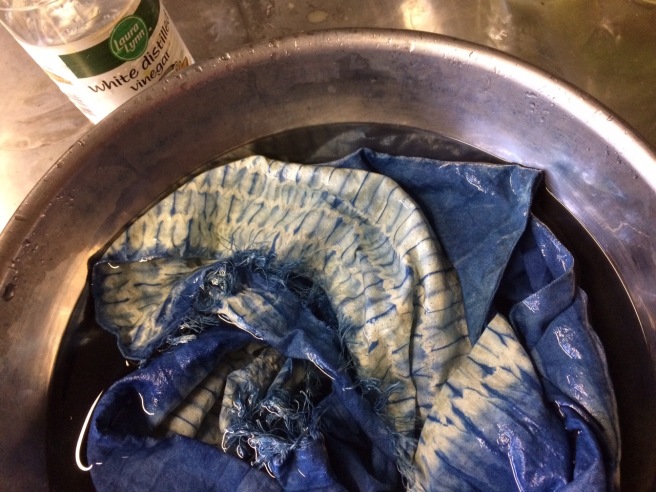
Many years ago, I made the assumption that only protein fibers needed to be neutralized. That is definitely NOT the case. All fibers must be neutralized!
Neutralization takes place in a water bath, to which a few “glugs’ of white vinegar (5% acetic acid) have been added. This is equivalent to about 1 tablespoon (10 ml.) per liter of water. Allow the textile to soak in the vinegar bath long enough for the acid to fully penetrate into the fiber (a few minutes to one hour, depending on the density of the textile). You can actually see the color brighten during this step.
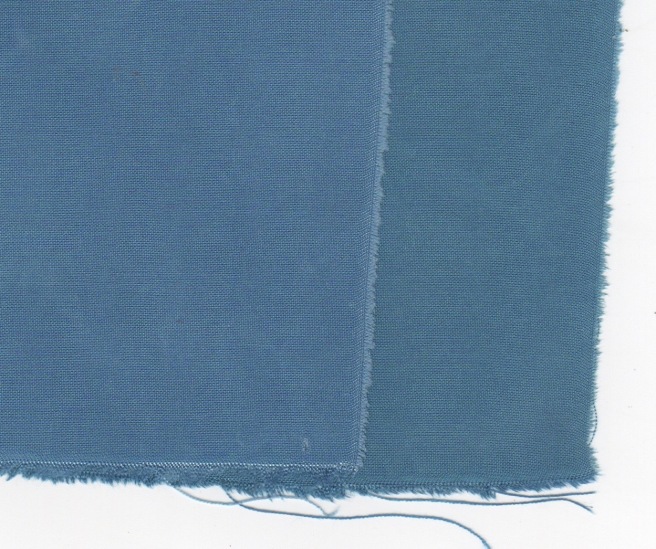

Next, the textile must have all excess dye completely removed. The best way to do this is in a heated bath, to which a small amount of pH neutral detergent is added. Heating will cause the vat dye molecules in the fiber to combine into larger units, making them stronger, while also removing excess dye that has not attached to the fiber. Boil cellulose for about 10 minutes. Protein fibers can be heated to an appropriate temperature and maintained at that temperature for about 10 minutes. After this step a thorough rinsing should be performed. THAT’S HOW TO FINISH INDIGO!
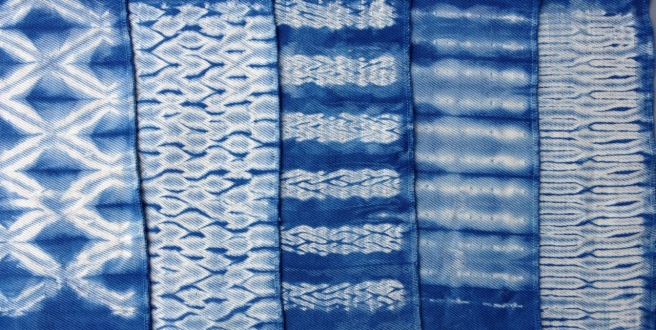
How did I come to understand all of this? I would still be wondering about much of it without my friend and colleague, Joy Boutrup. Joy is a Danish textile chemist, engineer and creative thinker. In an earlier post, I mentioned that we have taught together many times at Penland School of Crafts. Joy has helped me to understand process and the reasons behind the process. In its most recent issue, Fiber Art Now magazine has published a wonderful article about Joy, written by Lasse Antonsen. I encourage you to read it here.
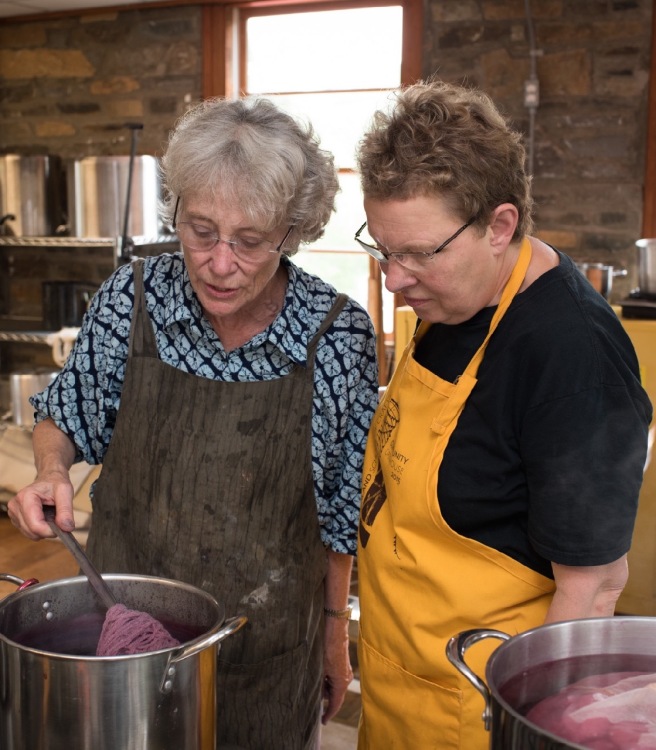
Joy and I are currently writing a book on natural dyeing! It will be a practical handbook for dyers, which not only explains HOW to dye but WHAT is happening in the process and WHY we might choose one process over another. Schiffer Publishing Co. will publish the book. Release date is targeted for late 2018.
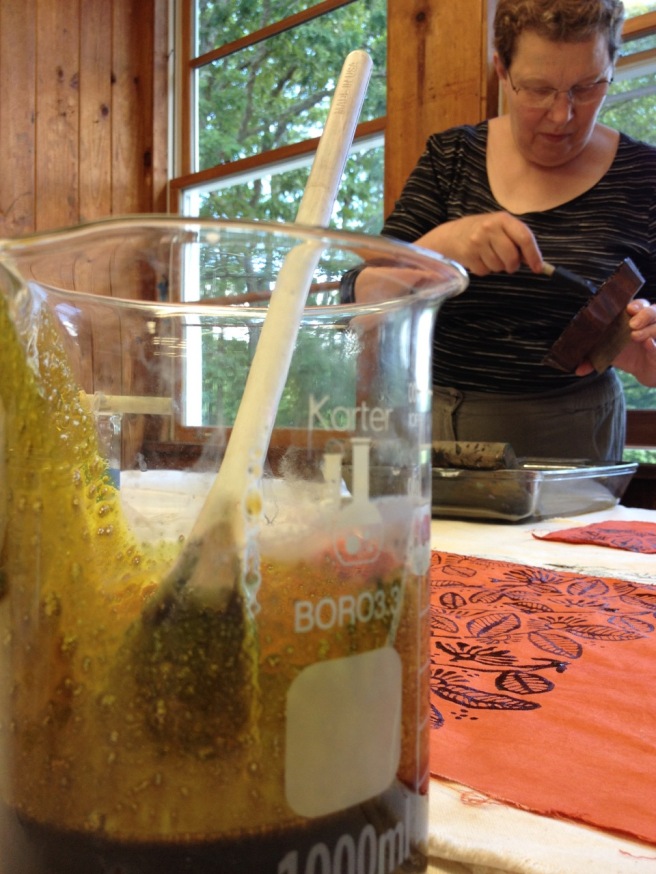
As I work through studio processes and words of explanation for the book, I realize how much I have learned from Joy’s deep understanding and perspective and I value her as a collaborator. Our book should help all of us to become better dyers.

Can I get on a list to be notified when you book is available, please?
Absolutely. And I will post information here as we come closer. Right now, Joy and I are very much immersed in writing, sampling, and photos.
I would like to be notified when your book is ready too. Thanks, Peggy Cox
I just preordered your book on Amazon and can hardly wait til end of October!
Will you have instructions on how to care for our naturally dyed ecoprints after printing? Like neutralizing iron, drying, curing, washing, ironing, etc? I am following several ecoprint fb groups and have studied with a few masters, but it seems the best practices are unsettled. Looking forward to your book!
HI Linda, I do not do eco printing so I cannot speak to those specific applications but the book will include information on good dye practices, finishing and caring for textiles, and the use of iron. Thanks for pre-ordering the book!
Thank you so much for this information. Dorothy Yuki
On Sat, May 6, 2017 at 5:45 PM, Natural Dye: Experiments and Results wrote:
> Catharine Ellis posted: “Last week I received several questions about how > to finish textiles after dyeing with indigo. What now comes naturally to > me, I realize, is not well understood by all dyers. First, back to the > dyeing: the textile should be dyed in long immersion baths (1” >
What is the estimated price of your book ? Will there be a pdf version ? And does the content also suggest the good mordant for natural dyes because there is much information on the internet about the mordant.
It’s too early to know the estimated price yet, but the goal is to make it affordable. Schiffer specializes in printed books, so I’m not sure about the pdf. There is an entire chapter devoted to mordants. I have learned so much in the research and testing done for this book!
I noted, thanks.
Thank you for all you do! This post on finishing Indigo is especially relevant to me right now. Up until now I have not put my indigo in a heated bath.
Looking forward to your new book and your workshop in Florida next March.
Very important indigo info—-thank you! & please hurry with that book!
You always have such great information. Im looking forward to buying your book. It’s sure to be a fantastic tesource!
You are right! i have been dyeing with indigo for years and have had talented teachers but they have never explained about finishing the fabric in this way. Thanks so much for the detailed information.It’s really interesting to see photos of the brightening of the fabric after neutralising. Look forward to the book
Thanks Catharine for this simple and timely explanation of the neutralisation process, chemistry is not my strong point but I do need to absorb the information too! I greatly look forward to your book with Joy.
This was so helpful Catharine! Thank you. VERY much looking forward to the book. And wondering if you and Joy will be teaching together sometime in the next year or so?? I live overseas, very willing to travel but need some advance warning and planning!
Joy and I are teaching a 2 day class on cotton printing at the ETN conference in Sweden, September, 2017. We will also be teaching at Maiwa in Vancouver, Canada in the fall of 2018.
Many thanks Catharine! Too long a trip for two days – I will set my hopes on Maiwa.
Catherine,
Thanks for sharing this. I had a couple of small pieces from a shibori class that had not been neutralized. That class was SOME time ago. As soon as I read this last night, I got out of my chair and treated the pieces. They look fine and I feel so much better!
Martha Barnes Nelson
>
Your thorough, clear and dare I say simple explanation makes great sense! Thank you for clear writing and I am anticipating your collaborative book with great excitement!
Hello Catharine, thank you for all your very clear explanations, I love your posts et and I will buy your book as soon it is available ! I am going start indigo & woad vats within one week for demonstration in our garden – without teachers this time – so I am really stressed ! PS : for murasaki, I have got a lot of informations about how to grow and when collect the roots (and I got 300 gr of roots from Hong-Kong this year… I will try when I have time – this summer I suppose).
Please continue to give us some posts from time to time even if you are busy with your book !
Françoise from France
I have some fabrics that I dyed a year or more ago with Indigo and I haven’t used them yet. Do you think it would still be beneficial to put them through the post dyeing boiling water process after all of this time? I’m excited t hear about the book you and Joy are working on. Will it include information on dyeing with natural dye extracts or only raw materials? I appreciate your thorough explanations of your experimental processes in your posts. Thank you!
Joy Jensen from Colorado
Hi Joy, I would certainly think it would be beneficial.
A question Catharine. When using indigo with woven shibori, at what point in the process do you remove the gathering strings during this neutralization, boiling, and rinsing?
Usually I remove the gathering threads before neutralization and cleaning. That way I’m sure to neutralize the whole textile.
Thank you for sharing your knowledge with us! I learned this finishing process from Elin Noble. I recently was finishing a piece that I dyed with Indigo and then overdyed with osage orange. I did not use any mordant before dyeing with the osage thinking that it is a natural tanin and I wouldn’t need it. But after I did the heated bath to with some ph neutral soap most of the osage was washed out. Do you think I should have done the neutralizing and cleaning first and then overdyed with osage orange? Do you think that I need to apply mordant after indigo and then dye with osage? Thanks for you input.
Osage requires a mordant. It’s best to apply that mordant after the neutralization of the indigo. The acidic mordant further insures that the textile is neutralized and the dyeing in osage bath will, in effect, boil out the excess indigo.
Bring it ON!! thank you in advance for all your hard work.
That is great info! Thank you!
Hello Catherine, I’m familiar with neutralizing but wanted to clarify the first step you mention, “First, back to the dyeing: the textile should be dyed in long immersion baths (10-20 minutes). Without the long immersion, the dye will only sit on the surface of the textile and will not be lightfast.” Is this referring to an immersion in the indigo vat or overdyeing with an additional dye after the indigo but before neutralizing? I think I’m missing something right there. And a “hello” from Peacham!
Jane, I’m referring to the indigo dyeing. That should be long, slow dips in the vat. and “Hello Peacham!”
Thank you, Catharine! And Joy! Such good information as always. I look forward to reading the book.
I know it will be an invaluable tool for all natural dyers. Barbara
I am so excited about your book and appreciative of all the information you share on this blog. Thank you!
Thanks for such a detailed post. I do have a question about the long dips. I use a flour resist paste, similar to Adire technique used in Nigeria. Long dips would weaken and dissolve the paste. I currently do 5-6 two minute dips.
Will the fabric not be lightfast? Should I use a weaker vat and do more dips?
Using paste resists can be tricky and you need to find the correct balance between a good resist and time in the vat. Then be objective about the results. Just test your textile for lightfastness.
Hi Catharine, thank you so much for this post. It has been a nagging concern that the alkalinity of the fabrics could cause damage later. Thank you for dealing with this issue.
Thank you for your clear concise instructions ….I’m looking forward to the publication of your book.
I am grateful for these instructions for neutralizing indigo-dyed cotton (and other vegetable fibers?) Is there any point in neutralizing a 30 yo indigo-dyed cotton jacket that has yellowed at the neck? My dye group made an indigo shibori cotton quilt about 6 years ago, and over time it has faded. We couldn’t figure out how to stop that. Is it too late to neutralize that piece? I look forward to your and Joy Boutrop’s book. I remember following her work with SDA in the 90’s.
I am assuming the vat is an organic vat. The longer dips are an issue if it is a thio vat.
Looking forward to the book!
Thank you! It is all encompassing right now!
Have you ever finished your indigo cloth by pounding it with a wooden mallet or by some of the other methods explained in the book, Imprints on Cloth by Sadae Torimaru and Tomoko Torimaru.
No, I have not yet tried any of those types of surface finishing techniques but I have worked with students who have tried it.
Stop answering posts and get the book finished!!!
I’m amused! 10 minutes after you posted this comment, you asked your own questions… Hope the answer is useful. Book is out of my hands right now – at the publisher (Schiffer) and in the capable hands of the design team.
Dear Catharine,
first of all, thank you for your hard work. I have pre-ordered your book!
Since you advise on boiling the cellulose fibres for about 10mn, does this mean that the pigment will not deteriorate in temperatures above 100 degrees celsius?
This is a big doubt I have: what do you think is the limit temperature for indigo to start deteriorating?
thanks in advance
Once the dye is attached to the fiber, there is no harm in boiling the textile. It will only help the remove dye that has not attached. I think the caution about temperature has more to do with the indigo in the reduced (vat) form. Fermentation vats are particularly fussy about temperature and chemical vats work best at specific temperatures.
When i pre-ordered my copy in Sept, it told me it would be released Oct of this year, yesterday it said November, and now JANUARY 2019????? Any idea of the real time frame, please?
This was news to me yesterday, too. There are good reasons for the delay and I’ve just posted a new blog to explain. Sorry! I’m disappointed, too.
Will this method work on wool? Thanks in advance.
Yes, wool should be neutralized as well – and as the post indicates the excess indigo should be removed with a very hot wash.